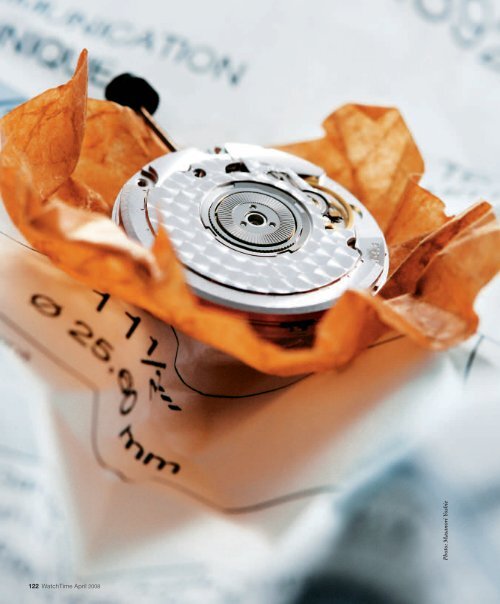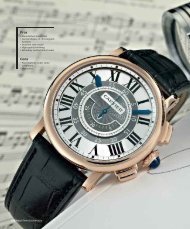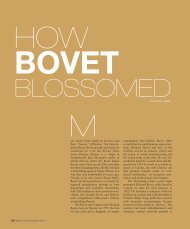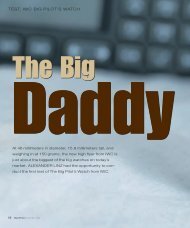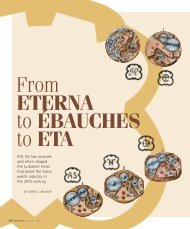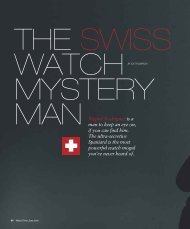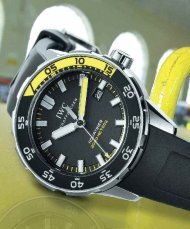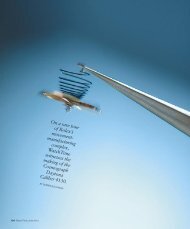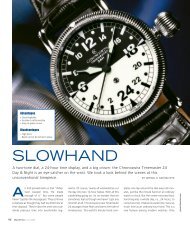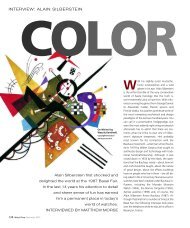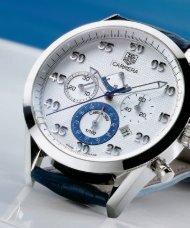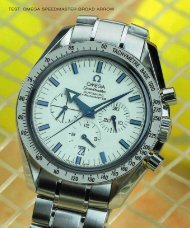WT_2008_02: MOVEMENTS: ETA 2892
WT_2008_02: MOVEMENTS: ETA 2892
WT_2008_02: MOVEMENTS: ETA 2892
- No tags were found...
Create successful ePaper yourself
Turn your PDF publications into a flip-book with our unique Google optimized e-Paper software.
122 WatchTime April <strong>2008</strong>Photo: Masanori Yoshie
Slim, precise, powerful and reliable,<strong>ETA</strong>’s Caliber <strong>2892</strong> has become one ofthe watch world’s most popularmechanical movements and the basefor a variety of additional complications.TheLittleEngineThatCouldBY GISBERT L. BRUNNERApril <strong>2008</strong> WatchTime 123
<strong>MOVEMENTS</strong><strong>ETA</strong> <strong>2892</strong><strong>ETA</strong> 2897<strong>ETA</strong> 2896, with big dateThe skeletonized version ofchronograph movement 2894S2Eterna-Matic with ball-borne rotor(1948) and Eterna-Matic 3000, regardedas the predecessor of Caliber <strong>2892</strong>.Stamm retired in 1969. Ten years later, theSwiss Society for Chronometry awardedhim a gold medal in recognition of his numerouscontributions to horology.WITH A HEIGHT of just 3.6 millimeters(including the jumping date display belowits little window), the Eterna-Matic3000 was the slimmest caliber with a centralrotor. Five factors made this achievementpossible: the steeply beveled basemovement; the close spacing of all components,without significant reductions intheir size, in order to create a tub-shapedempty space; the insertion of the geartrain for the self-winding mechanism intothis space; the altered profile of the oscillatingweight, consisting of a flat plate inthe center and a heavy metal segmentwith stepwise terraces toward its periphery;and a bearing with a large diameterand seven (rather than the previous five)balls, each of which could be reduced indiameter from 65 to 60 1/100 mm.The combination of all these elementsmade it possible to reduce the overallheight by 25 percent compared to thepreceding “Centenaire” family of calibers.The 3.1-mm thickness of the baseCaliber 1438 was kept unchanged, butthe amount of headroom needed by therotor and the self-winding assemblycould be reduced by half a millimeter.Other distinguishing features include adirectly propelled central seconds hand, aminute hand situated outside the flow offorce, gears made of beryllium bronze,and curved toothing which, thanks toStamm, had already been implemented in1951. This ambitious venture would havebeen impossible without this specialtoothing. Furthermore, the watchmakerscontinued to use the earlier solutions ofratchet-wheels without springs to polarizethe rotor’s motions and to uncouple126 WatchTime April <strong>2008</strong>
the manual winding when a user windsthe mainspring by hand.A watch repairer need only unscrewthree screws to completely remove the insetself-winding assembly from the movement.The technicians inset the numberring and the switching work of the digitaldate display into a milled indentation onthe front of the plate, thus keeping its 3.6-mm height unchanged. Leaving out a centralseconds-hand would have saved another0.3 millimeters, but this option wasnever seriously considered.The Eterna-Matic 3000 Dato madeheadlines when it debuted in 1963. Journalistslauded it as a milestone in watchhistory, and particularly praised its efficient,low-cost, large-series production. Itis fair to say that the new movement (designatedCaliber 1466), and the followingversion (Caliber 1504), with a balanceoscillating at a frequency of three hertz(21,600 vph), represented essential stepsforward into the modern era of self-windingwristwatches.THE PROOF is in the astounding successof <strong>ETA</strong> Caliber <strong>2892</strong>, which made its entryonto the watch stage in 1975 — a lowpoint in the history of mechanical timekeeping.The technicians — foremostamong them Urs Giger, born in Solothurn,Switzerland in 1929 — had devoted intensivework to the new product and had givenit, among its other distinguishing features,a balance that oscillated at a readilycontrollable frequency of four hertz. These28,800 hourly semi-oscillations facilitatedits regulation and contributed to its abilityto maintain its initial precision longer thanwould have been possible if it had been designedto oscillate at three hertz. While theflood of new quartz watches in the markettook its toll on the traditional manufacturers,this 11½-ligne caliber staunchly heldhigh the banner of mechanical timekeeping.Caliber <strong>2892</strong> preserved <strong>ETA</strong>’s triedand-testedself-winding principles: ballbornerotor, self-winding gear train withclick-wheel reverser to polarize the rotor’smotions, service-friendliness thanks toThe <strong>ETA</strong> <strong>2892</strong> FamilyName Diameter and Height Description2890-9 25.6/5.2 mm <strong>2892</strong>-2 without seconds hand; has perpetual calendar with leapyearand moon-phase displays; launched in 1990. 2890 has noperpetual calendar2891-9 25.6/5.2 mm Mostly identical with 2890-9 with perpetual calendar, but also hascentral seconds hand, stop-seconds function; <strong>ETA</strong>’s top-of-thelinecaliber; launched in 199<strong>02</strong>893-1 25.6/4.1 mm Quickly adjustable date display, plus “heure universelle” worldtimedisplay, 24 city names on central disk2893-2 25.6/4.1 mm Quickly adjustable date display, plus additional 24-hour hand forthe time in a second time zone2893-3 25.5/4.1 mm 2893-1 without date display2894-2 28.0/6.1 mm Chronograph mechanism is mounted on the front side and hascam switching, counters for 30 elapsed minutes and 12 elapsedhours, plus date display (quickly adjustable) below the dial;37 jewels; no module because the switching movement is mounteddirectly on the front side of the plate; launched in 19962894S2 28.0/6.2 mm Skeletonized chronograph, no date display2895-2 25.6/4.35 mm Additional module for the seconds subdial at 6 o’clock2896 25.6/4.85 mm Quickly switching big date (two windows) at 3 o’clock; 22 jewels,launched in 20042897 25.6/4.85 mm Displays the date and the remaining power reserve, 21 jewels;launched in 2004April <strong>2008</strong> WatchTime 127
<strong>MOVEMENTS</strong><strong>ETA</strong> <strong>2892</strong>AN <strong>ETA</strong> <strong>2892</strong> SAMPLER1472583 961. Bell & Ross BR 01-92 Phantom (<strong>ETA</strong> <strong>2892</strong>)2. Ebel Brasilia Chrono Gent (<strong>ETA</strong> 2894)3. Custos Challenge QP-S (<strong>ETA</strong> <strong>2892</strong> withperpetual calendar module and palladium/titaniumrotor)4. Anonimo Dino Zei San Marco (<strong>ETA</strong> <strong>2892</strong> withSoprod module)5. Arnold & Son True Moon (modified <strong>ETA</strong> 2893-2)6. Sinn 1746 Classic (“Top” <strong>ETA</strong> <strong>2892</strong>)7. Victorinox Dive Master 500 Limited Edition(<strong>ETA</strong> 2896 with big date)8. TAG Heuer Carrera Calibre 360 (<strong>ETA</strong> <strong>2892</strong> withchronograph module)9. Hanhart Minos (<strong>ETA</strong> 2895)10. Carl F. Bucherer Patravi Chronograph Big Date(<strong>ETA</strong> <strong>2892</strong> with Dubois Dépraz 4500 module)At a relatively low cost to manufacturers,the <strong>ETA</strong> <strong>2892</strong>A2 is extremely robustand reliable. It offers plenty of watchmovement in a small volume of space, aswell as ample opportunities to add evenmore capabilities. As with other selfwindingcalibers, the list of extras is longand comprehensive. Worlds of differencecan separate one <strong>2892</strong>A2 from another.<strong>ETA</strong> offers this caliber in three versions:“Elaboré” with nickel balance, “Top”with Glucydur balance, and“Chronomètre” with Glucydur balanceand official chronometer certification.Gold-plated movements and special versionsare also available, not to mention10130 WatchTime April <strong>2008</strong>
<strong>MOVEMENTS</strong><strong>ETA</strong> <strong>2892</strong>Maurice Lacroix MasterpieceJours RetrogradesWhy is the <strong>ETA</strong> <strong>2892</strong> so Popular? Experts Weigh In“The <strong>ETA</strong> <strong>2892</strong>A2 self-winding mechanical movement is withouta doubt the caliber that’s used most frequently as a base for thedevelopment of complication modules. Produced in large quantitybut also with good quality, this movement offers a reliableperformance. Furthermore, it’s rather slim – one of the slimmestmovements in this category. This makes it an ideal base for interestingcomplications. It satisfies all our demands with regardto stability, quality and industrialization. Analyses conducted byour watchmakers show that we can rely on it to provide the highquality that we insist upon for our own calibers. Thanks to its“The <strong>ETA</strong> <strong>2892</strong> has many positive aspects, two of which deserveparticular mention: superlative isochronism andsmall dimensions. This movement’s diverse spectrum ofmodules satisfies the specific requirements that wereceive from our R&D division as specifications foreach new development. For example, we use the<strong>ETA</strong> <strong>2892</strong> as the base caliber for a Parsifal model into“We use the <strong>ETA</strong> <strong>2892</strong> as the base movement forapproximately 20 of our module movements. Eachmodule is developed with Dubois Dépraz, whichproduces it exclusively for Breitling. As long ago asthe 1960s, Dubois Dépraz already had the idea of alwaysusing the same basic movement as the powervarious advantages, which include highquality, stable performance and low overallheight, the <strong>ETA</strong> <strong>2892</strong> offers plenty oflatitude for us to put our own ideas intopractice. These reasons are why it’s so popularin the watch industry, but this popularitycan also cause capacity problems.”— Sandro Reginelli, Product Director, MauriceLacroixwhich we’ve integrated the power-reserve displayas a complication module provided by La Joux-Perret. We’re verysatisfied with the options offered by this caliber. It fully satisfiesour expectations and our demands. One could, however, enlargethe movement’s basic size in order to meet the future need forlarger watches and thus larger openings.”— Eric Yersin, Technical Director, Raymond Weilsource. For Breitling, this always meant a chronograph plus additionalfunctions such as a big date, a flyback function, a counterfor 30 elapsed seconds for the chronograph, and similar additionalfunctions. The <strong>ETA</strong> <strong>2892</strong> delivers very high performance ina small package and offers us numerous options.”— Jean-Paul Girardin, Vice-President, BreitlingBreitlingBlackbird“The <strong>ETA</strong> <strong>2892</strong> is a mature movement and it worksvery reliably. Thanks to its low height, it can be usedvery flexibly. Plenty of diversity is assured through thedifferent add-ons with various functions such aschronograph, power-reserve display or second timezone. There’s essentially no need to improve thismovement. Of course, at a certain price level, a customerhas a right to expect a wristwatch to contain abase movement made by the watch’s brand. The powerreserve could be lengthened to last more than 46hours. As a base movement, the <strong>ETA</strong> <strong>2892</strong> has itslimitations: practically only modular add-onsare possible, and the stability, size andtorque all have their limits. That’s why forthe new world-time module in Eterna’sPorsche Design Worldtimer, we had to relyon an <strong>ETA</strong>-Valgranges movement becausethe module wouldn’t have fit on an<strong>ETA</strong> <strong>2892</strong>.”— Patrick Kury, Technical Director, EternaEternaDivermodels supporting a wide array of additionalfunctions.The <strong>ETA</strong> <strong>2892</strong> also serves as a basefor more exacting demands — at least until2010, when <strong>ETA</strong>, with permissionfrom the Swiss legal authorities, will terminatesales of movement kits. Untilthen, specialized enhancers such asDubois Dépraz, La Joux-Perret and Soprodwill continue to offer everythingone’s heart could possibly desire: engravings,rotors crafted from precious metals,PVD coatings, etc. The modules includechronographs, power-reserve displays,and a repeater movement with chimes.The trusty <strong>2892</strong>A2 served as the base forOmega’s Caliber 2500, introduced in1999, the first to incorporate GeorgeDaniels’s co-axial escapement. All that’smissing is a tourbillon. Then again, awatch with a tourbillon wouldn’t run anymore accurately than the officially certifiedchronometer version of the <strong>ETA</strong><strong>2892</strong>A2. 132 WatchTime April <strong>2008</strong>


